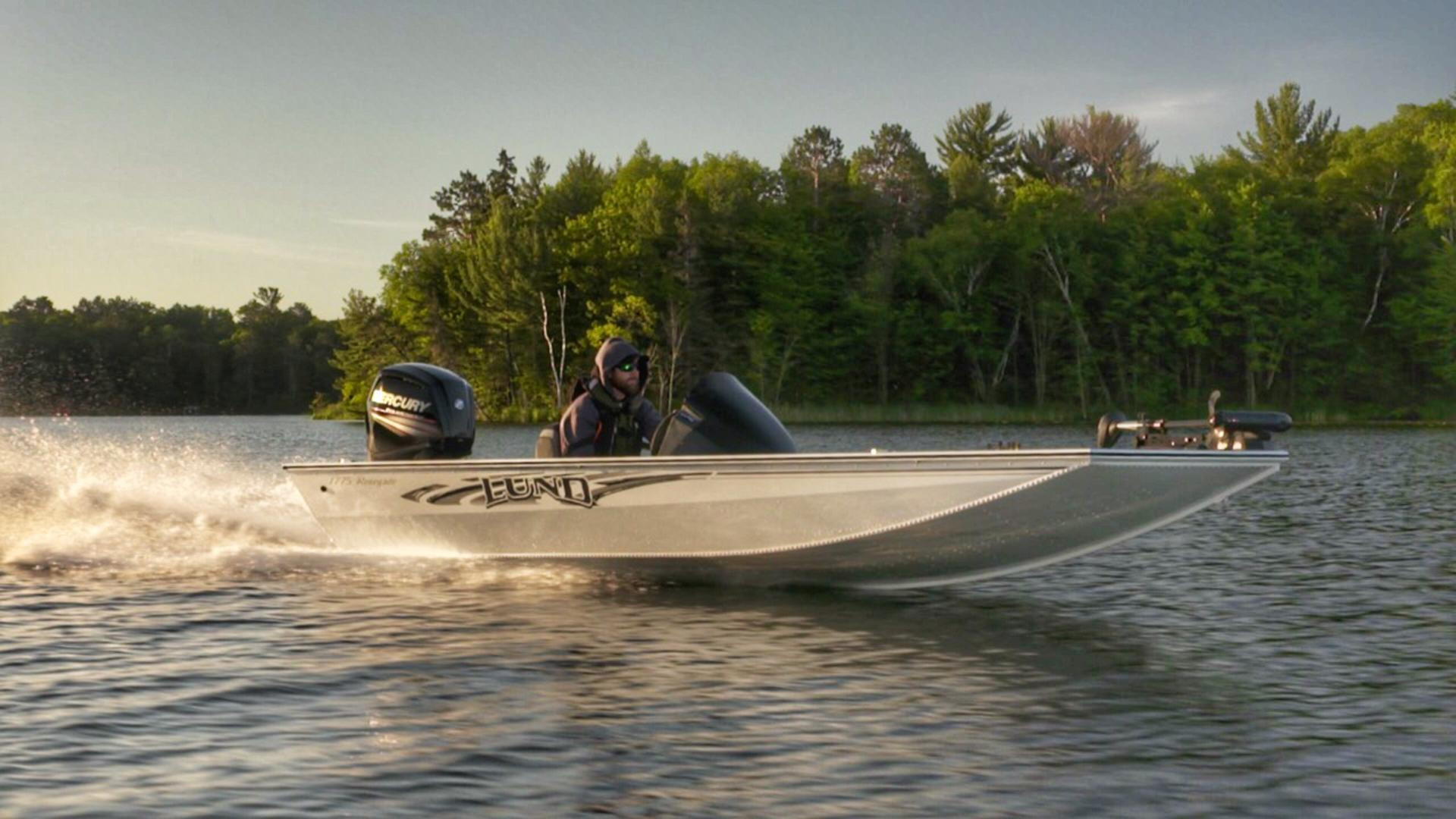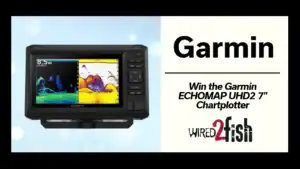Article by Walker Smith, Managing Editor
Video by Ryan DeChaine, Video Producer
The Wired2Fish crew had the opportunity to extensively test the Lund 2017 Renegade this summer. We had been hearing a lot of talk about this long-awaited series of Mod-V fishing boats, so we spent a solid week going over every single detail. Our ultimate goal was to leave no stone unturned throughout our evaluation.
We fished from it, caught bass from it and drove it—and it wasn’t just a peaceful sunset cruise, either. Hours upon hours were spent pushing this boat to its limits in order to evaluate essential performance elements such as hole shot, stability and maneuverability.
Keeping in mind what anglers most often look for when making a major purchasing decision, we’ll go over each aspect and give our thoughts on them.
The basics
The 2017 Lund Renegade comes in two models: The 1775 which measures 17 feet, 9 inches and is rated for a 90-horsepower motor and the 1875 which measures 18 feet, 9 inches and is rated for a 115-horsepower motor.
This series offers a model for both bass and crappie anglers. While each model boasts a roomy 95-inch beam and 22-gallon fuel capacity, the primary difference is found in the livewell placement.
In each bass model, you’ll find a 30-gallon aft livewell located behind the seats that is quite spacious for even the most successful days on the water. The pumps are strong and fill the livewells quickly, which makes boxing your first catch of the day quick and efficient.
The crappie models are designed with a 12-gallon bow livewell that’s easily accessible from the casting deck. If you’re planning on a big fish fry of crappie or other panfish species, anglers will appreciate the convenience of the livewell location. Not only does it save you steps throughout the day, but it also allows you to quickly box your catch and get back to the action and maintain boat position.
Storage
Anglers are renowned tackle junkies; we can never have enough. Choosing a boat with a practical and spacious storage layout is of the utmost importance. Gone are the days of tripping over your fishing gear, snapping rod tips and digging through piles of soft plastics to find the hot color—if you’re buying a new boat, you expect it to provide a viable solution to common problems.
We found the 2017 Renegade to be intelligently designed in regards to storage. The 1775’s port rod locker holds rods up to 8 feet in length and the 1875 holds rods up to 9 feet in length. The internal rod tubes keep your rods organized and safe from boat rash, while also ensuring they won’t be bent in storage.
The middle compartment of the casting deck is a perfect place to store your tackle trays filled with your must-have fishing gear. It’s easy to access and gives anglers plenty of room to sit to the side—with the compartment open—and quickly rig tackle during a day of fishing. We found the starboard storage compartment to be a great way to store your soft plastics and extra outerwear.
Lund also integrated a slick storage system beneath the roomy bench seats of the 2017 Renegade; it’s well done and you can’t even tell it’s there until you need it. Simply flip up the seats and you’ll have a place to store accessories such as culling beams, livewell treatment and spools of line.
In the back of the Renegade, both co-anglers and boat owners will enjoy two large storage compartments complete with drain plugs. They offer plenty of space for a full day of co-angling or extra drinks, snacks, boat tools and rain gear.
Fishing
Throughout our testing, we spent a considerable amount of time fishing from the 2017 Renegade. Sure, the fishing was fun—but we needed to see how the boat handled abrupt movements and weight shifts with multiple anglers. Again, if you’re going to spend the money on a new fishing boat, you don’t want one with the stability of a canoe.
The Renegade was incredibly responsive to even the slightest movement of the trolling motor. We targeted several shallow, backwater areas in which the bass were extremely skiddish and with the trolling motor on its lowest setting, we were able to easily maneuver the skinny water with minimal disturbance.
We also paid close attention to the stealth of this boat. Essentially, we wanted to ensure we could move about the casting decks of the boat without spooking wary fish with our footsteps. The Renegade was impressively quiet and even with boots on, our footsteps were quiet and covert.
The oversized casting deck is a great feature of this boat and perhaps the most important to many anglers. Two grown men can easily fish from the front deck without constant fear of flying treble hooks and tungsten. Our field producer, Kyle Peterson and I spent an afternoon fishing a swift river for smallmouth and while we’re both over 6 feet tall, we didn’t have any issues whatsoever.
The stationary stability of the Renegade is also worth mentioning. The boat doesn’t pitch dramatically to one side or the other when weight is shifted which is not only advantageous for everyday fishing, but also for safety. If we would have fallen into the fast-moving water, we would have been in a dangerous situation; but we felt one-hundred percent safe and secure while sharing the front deck.
Driving
As mentioned earlier, we didn’t baby this boat while testing it. We made a concerted effort to put it through everything imaginable including sharp corners, abrupt avoidance maneuvers and long runs at top-end speed.
Featuring Lund’s highly regarded IPS hull, the Renegade is designed with reverse chines, a flat center pad and a full-length center keel. This resulted in an excellent ride in several different ways.
With a 90-horsepower 4-stroke motor, we were able to get the 1775 Renegade to 44 miles per hour at top-end speed which is outstanding for an aluminum boat of its size. The hole shot was quick and the bow dropped quickly, giving us a clear field of view for maximum safety.
We were actually quite surprised by the bow lift of this boat. While many other aluminums tend to plow even with a fully trimmed motor, the Renegade’s bow lifted quickly and easily which increased acceleration and increased maneuverability.
Aesthetics
Everyone has different preferences when it comes to boat aesthetics, but the Wired2Fish crew has fairly similar tastes. We’re not too big on the gawdy, loud colors; we want a boat to look clean and streamlined.
The 2017 Renegade fits the bill, in our opinion. The lines are smooth, the colors are bold and the modest Lund graphics fit the flow of the boat excellently. It features a beautiful fiberglass Pro V Bass console and the gauges are easy to read while the control panel switches are attractive, yet simple and straightforward.
We were equally impressed by the Renegade’s flip-up cleats. Not only do they promote a clean look, but they also stay out of the way while fishing and reduce inadvertent line tangles and snags.
Lund also put a touch of bling on this new boat by installing integrated bow and aft LED lighting. Don’t worry; it’s not going to look like you’re at a disco. They’re there for functionality. Whether you’re night fishing or rigging tackle after hours, the lights are extremely bright and allow for outstanding visibility in all situation. When they’re off, you can’t even tell they’re there.
Final impressions
We were big fans of the 2017 Lund Renegade series. It fishes well, it has an intelligent layout and it performs well for a boat of its size. There’s only one negative: We couldn’t tow it home with us.
If you’re considering a new aluminum boat purchase, we suggest taking it on a test drive to experience it for yourself.










